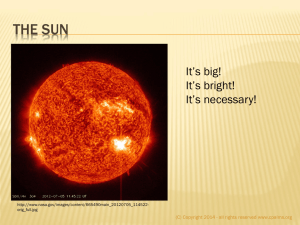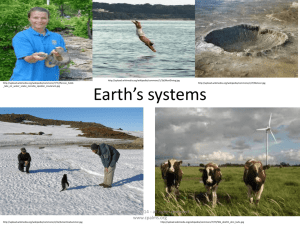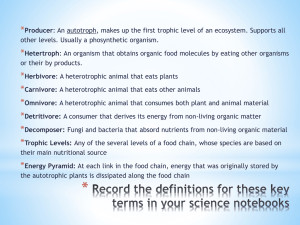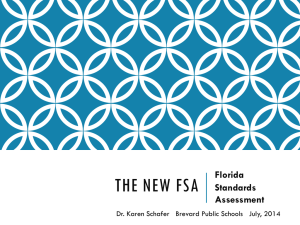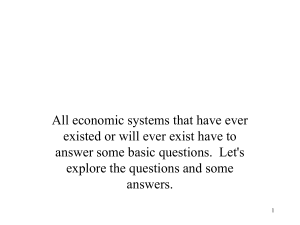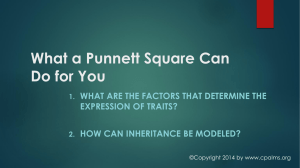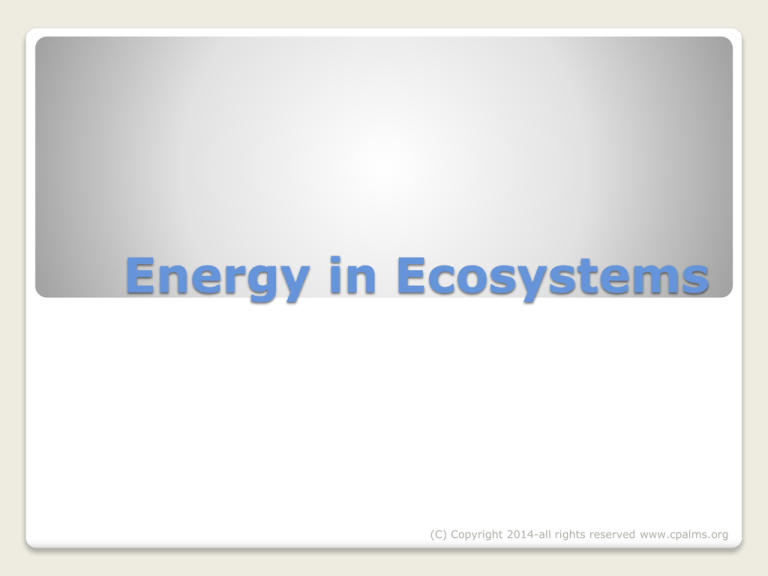
Energy in Ecosystems
(C) Copyright 2014-all rights reserved www.cpalms.org
Do Now
Please answer the following questions
to the best of your ability. Answer in
complete sentences.
Where do organisms get their energy
from? Give at least 3 different organisms,
and identify where they get their energy
from? Example: Humans get their energy
from food such as meat, dairy, fruit,
vegetables etc…
(C) Copyright 2014-all rights reserved www.cpalms.org
Objectives
Students will be able to:
Describe the movement of energy between the
trophic levels of an ecosystem.
Compare and contrast producers, consumers
and decomposers and how they contribute to
the transfer of energy through trophic levels.
(C) Copyright 2014-all rights reserved www.cpalms.org
Important Vocabulary
Producer
Autotroph
Consumer
Heterotroph
Chemosynthesis
Food Chain
Herbivore
Carnivore
Omnivore
Detritivore
Decomposer
Trophic Level
Food Web
(C) Copyright 2014-all rights reserved www.cpalms.org
Producers and Consumers
Producers: “AUTOTROPHS”
Get their energy from non-living
resources.
Ex. Plants, algae, phytoplankton
Consumers: “HETEROTROPHS”
Get their energy by eating
living, or once living resources.
Ex. Animals, fungus
(C) Copyright 2014-all rights reserved www.cpalms.org
Chemosynthetic Organisms
Organisms in the
Domain/Kingdom:
Archaebacteria
They produce their energy
by CHEMOSYNTHESISthe use of chemicals not
sunlight to make energy
(carbohydrates)
They are mostly found
near hydrothermal vents
on the ocean floor.
(C) Copyright 2014-all rights reserved www.cpalms.org
Practice Question #1
If you are at the park taking pictures of
wildlife and you come across a bee taking
nectar from a flower. Which is the producer?
Which is the consumer?
A.
Bee=producer, flower=consumer
B.
Bee=consumer, flower=producer
(C) Copyright 2014-all rights reserved www.cpalms.org
Practice Question #2
You are studying various heterotrophs, which
of the following are you studying?
A.
B.
C.
D.
Hummingbird
Cactus
Sea grass
Soil
(C) Copyright 2014-all rights reserved www.cpalms.org
Practice Question #3
Where do autotrophs get their energy from?
a.
b.
c.
d.
soil
water
sunlight
themselves
(C) Copyright 2014-all rights reserved www.cpalms.org
Food Chain
Is the simplest model that links species by
their feeding relationships.
(C) Copyright 2014-all rights reserved www.cpalms.org
Types of Consumers
Herbivores: are organisms
that eat only plants. ex. Rabbits
Carnivores: are organisms
that eat only animals. ex Hawks
Omnivores: are organisms
that eat both plants/animals.
ex. Humans
Detritivores: are organisms
that eat dead organic matter
"detritus" ex. millipede.
decomposers such as fungi.
(C) Copyright 2014-all rights reserved www.cpalms.org
Practice Question #4
Herbivores are which of the following?
a.
b.
c.
d.
producers
secondary consumers
primary consumers
decomposers
(C) Copyright 2014-all rights reserved www.cpalms.org
Practice Question #5
Which of the following shows a single
sequence of feeding relationships in an
ecosystem?
a.
b.
c.
d.
energy pyramid
food chain
food web
consumer chain
(C) Copyright 2014-all rights reserved www.cpalms.org
Food Web
Shows the complex
feeding relationships
within an ecosystem.
Each arrow points to the
consumers
Each arrow shows the
direction of energy
transfer.
During each transfer,
energy is lost to
metabolic processes and
the environment.
(C) Copyright 2014-all rights reserved www.cpalms.org
Energy Pyramid
Displays the levels of
nourishment (trophic
levels) in a food chain.
Energy transfer is
Ineffecient.
Producers (bottom)
have the most energy
Transfer between
trophic levels is about
1/10
(C) Copyright 2014-all rights reserved www.cpalms.org
Practice Question #6
Create an Energy Pyramid from this food
chain. Include Producer/Consumer labels.
(C) Copyright 2014-all rights reserved www.cpalms.org
Practice Question #7
A diagram of a food web
is shown to the right.
Which organism receives
the most amount of energy
from the producers?
a.
Owl
c.
Fox
b.
Snake
d.
Mouse
(C) Copyright 2014-all rights reserved www.cpalms.org
Do Now
Isolate one complete food chain from the given
food web. Make sure to label the different
trophic levels (levels of nutrition).
(C) Copyright 2014-all rights reserved www.cpalms.org
http://g6n.wikispaces.com/file/view/images.jpg/3
35273742/images.jpg (producer/consumer)
http://theseamonster.net/wpcontent/uploads/Hydrothermal-vent-NOAA-PMELVents-Program-590x442.jpg (chemosynthetic)
http://www.field-studiescouncil.org/urbaneco/images/011-food-chain.jpg
(food chain1)
http://mun3484.wikispaces.com/file/view/food_ch
ain.jpg/280760194/food_chain.jpg (food chain2)
http://www.biologycorner.com/resources/foodweb
1.gif (food web)
http://images.tutorvista.com/content/ecosystem/f
ood-web-forest.jpeg (food web last do now)
(C) Copyright 2014-all rights reserved www.cpalms.org

